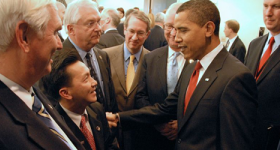Asian Americans and Pacific Islanders marked new milestones in politics after the 2012 election, with a record number elected into Congress. Out of 31 AAPI candidates who ran during the primary election, 18 moved on to compete in the general election, and six became newly elected members of Congress. It was the largest number of AAPIs to have run for Congress and the largest number of AAPIs elected at any point in U.S. history.
But these accomplishments remain far from what is needed for proportional representation of AAPIs based on their burgeoning population. (AAPIs are now the fastest-growing minority group, particularly in the South, according to the most recent census). Proportional representation means that Congress would better reflect the increasingly diverse U.S. population - constituents would be more likely to be represented by an elected official who shares their background and who may be easier to lobby directly to.
Thirty-one AAPI representatives in Congress would signify proportional representation, according to the New American Leaders Project, a nonprofit organization focused on training first and second generation immigrants in civic leadership. There are now 11 AAPIs serving in Congress. But Congresswoman Judy Chu, chair of the Congressional Asian Pacific American Caucus (CAPAC), points out that the 113th Congress, with more women and minorities than ever before, “represents a tremendous step forward for our country.”
“This past election, the American people spoke and they chose leaders who more closely reflect the diversity of this nation than at any other time,” Chu said.
Barriers to Running for National Office
Several obstacles persist towards proportional representation. For one, finding candidates to run for national office remains a challenge. Many AAPI elected officials at the state and local level remain satisfied in their current positions and may not aspire to federal positions, according to Mee Moua, executive director of the national civil rights groups Asian American Justice Center and a former Minnesota state senator.
Those who do want to run could face strong incumbents with no plans to give up the seat.
Additional barriers come down to dollars and cents. The cost of federal campaigns has significantly increased over the past 10 years. A House of Representatives race could cost a candidate anything from $500,000 to millions of dollars, according to estimates by the Washington Post.
“The cost of federal campaigns is one of the things that will keep really good people from running,” Moua said. “Unless we can build a financial support infrastructure and support our candidates, it will continue to be a challenge.”
But a few South Asian candidates are laying the foundation for expensive future campaigns. Ro Khanna, a former US deputy commerce secretary, successfully raised $1.2 million in one quarter in 2012, much of it from Silicon Valley donors, before deciding against running for Congress due to Congressman Pete Stark’s incumbency. Aneesh Chopra, former U.S. chief technology officer, has declared his candidacy to run for lieutenant governor of Virginia in 2013, after already raising $500,000, according to the Washington Post.
Being an immigrant, experiencing language difficulties, and generally having a lack of knowledge of American politics have prevented more AAPIs from running and winning races, according to Theresa Thanjan, national co-chair of the community engagement group South Asians For Opportunity.
“Some may feel an affinity towards their countries of origin and may not be as invested here,” Thanjan said.
New Landscape Creates AAPI Opportunities
These challenges could ease as the country shifts and becomes more accepting of candidates from diverse backgrounds.
Due to California’s redistricting in 2011, District 17 in San Jose became the first Congressional district where the majority of the population is AAPI. Many call these “opportunity districts,” where AAPI electoral candidates are assumed to likely succeed. However, Congressman Mike Honda, who represents District 17, pointed out to the LA Times that none of the newly elected officials in any other state, with the exception of Hawai’i, came from AAPI majority districts. This means that successful AAPI candidates did not necessarily depend on large AAPI populations as voting blocks.
Indeed, AAPI candidates are increasingly being seen as viable, effective representatives for all constituents, according to Congresswoman Chu.
“People of all ethnic backgrounds are giving these representatives a vote of confidence, and with that vote, saying that these Congress members can be good representatives for everyone,” she said.
Winning in swing districts is a notable accomplishment for AAPI candidates, demonstrating that they can have wider appeal in close races. Three out of six newly elected officials came from “red-to-blue” districts that were controlled by Republicans, but had a good chance of flipping to the Democrats.
But the makeup of Congress has gradually changed, giving more chances to candidates from diverse backgrounds. Congressman-elect Mark Takano is a Democrat from California who ran unsuccessfully in 1992. He noted that racial diversity was the main difference this time around, and he believes it was what attracted a lot of independent voters to vote for Democrats.
“I think it’s a great mark of progress,” he said.
The election also set a record for candidates from various sexual orientations. Takano was the first openly-gay person of color elected to the House of Representatives.
Many AAPI officials enter Congress through a traditional route, after serving in local or state elected office. This was the case during this election cycle for the most part, but “some of our newest members have demonstrated that they can go straight to Congress if there’s an opportunity,” according to Moua.
Ami Bera, a physician from California who has never held elected office, defeated incumbent Dan Lungren. Tammy Duckworth served as an assistant secretary in the US Department of Veterans Affairs, and her 2012 Congressional victory in Illinois was only her second run for office, after a failed run for Congress in 2006.
Building the Political Pipeline
Congresswoman Chu said that growing up, she never imagined the possibility of becoming an elected official because so few AAPIs held positions of power. Today, seeing other AAPIs serve remains vital for those who aspire to elected office.
“AAPIs are running for office because they feel that it can be done,” Chu said. “They’ve seen President Obama get elected. They’ve seen AAPI candidates win, and it makes them feel that they too can get elected, and that they too can make their voices heard right at the table where the decisions are being made.”
Current officials cite political pioneer-mentors, such as the late Congressman Robert Matsui and current U.S. Ambassador to China Gary Locke, who was the first Asian American to serve as governor of Washington.
Congressman-elect Takano emphasized the importance of mentorship in shaping young leaders and inspiring future candidates.
“I realize that I have a great responsibility because in addition to representing my district, I know that I carry the responsibility of also being a source of empowerment for AAPIs,” Takano said. “I feel I have a strong responsibility to be a mentor because people like [former Secretary of Transportation] Norm Mineta and [former California Representative] Bob Matsui were strong mentors of mine 20 years ago.”
Takano also counts Massachusetts Representative Barney Frank, who is also gay, as an influential figure.
Even President Barack Obama credits an AAPI as one of his earliest political inspirations. The late Senator Daniel Inouye, who represented Hawai'i in the House and Senate for 53 years, was a politician who Obama looked up to at a time when very few national leaders shared his multicultural background.
“Here I was a young boy with a white mom, a black father, raised in Indonesia and Hawai’i,” said Obama during Inouye’s funeral in December. “And so to see this man, this senator, this powerful, accomplished person who wasn’t out of central casting when it came to what you’d think a senator might look like at the time, and the way he commanded the respect of an entire nation, I think it hinted to me what might be possible in my own life.”
Early exposure to the political process and a more sophisticated support system of mentorship can help young AAPIs succeed in their aspirations to run for elected office. However, much of the political infrastructure, including fundraising groups and public service exposure programs, remains to be developed.
Only a handful of national AAPI political organizations exist that train, organize, fundraise, and endorse AAPI electoral candidates.
“One reason we don’t have a large number of AAPI elected officials is that we don’t have enough AAPI and South Asian Americans in the political pipeline,” Bera said. “Leaders in our community need to mentor and train the next generation.”
Moua remains optimistic and hopeful about the future of AAPIs in politics.
“This year’s class demonstrates the increasing bench strength of the AAPI electorate and increasing strength of AAPI demographics,” Moua said. “It takes at least a decade or two to plant the seed and build the bench. We’re beginning to see that ripeness.”
Erin Pangilinan is a writer for Hyphen‘s Politics section.










Comments